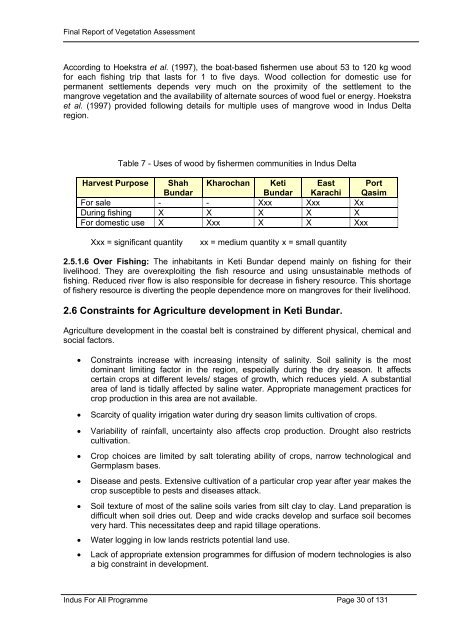Download - foreverindus.org - WWF - Pakistan
Download - foreverindus.org - WWF - Pakistan
Download - foreverindus.org - WWF - Pakistan
Create successful ePaper yourself
Turn your PDF publications into a flip-book with our unique Google optimized e-Paper software.
Final Report of Vegetation Assessment<br />
According to Hoekstra et al. (1997), the boat-based fishermen use about 53 to 120 kg wood<br />
for each fishing trip that lasts for 1 to five days. Wood collection for domestic use for<br />
permanent settlements depends very much on the proximity of the settlement to the<br />
mangrove vegetation and the availability of alternate sources of wood fuel or energy. Hoekstra<br />
et al. (1997) provided following details for multiple uses of mangrove wood in Indus Delta<br />
region.<br />
Table 7 - Uses of wood by fishermen communities in Indus Delta<br />
Harvest Purpose Shah Kharochan Keti East Port<br />
Bundar<br />
Bundar Karachi Qasim<br />
For sale - - Xxx Xxx Xx<br />
During fishing X X X X X<br />
For domestic use X Xxx X X Xxx<br />
Xxx = significant quantity xx = medium quantity x = small quantity<br />
2.5.1.6 Over Fishing: The inhabitants in Keti Bundar depend mainly on fishing for their<br />
livelihood. They are overexploiting the fish resource and using unsustainable methods of<br />
fishing. Reduced river flow is also responsible for decrease in fishery resource. This shortage<br />
of fishery resource is diverting the people dependence more on mangroves for their livelihood.<br />
2.6 Constraints for Agriculture development in Keti Bundar.<br />
Agriculture development in the coastal belt is constrained by different physical, chemical and<br />
social factors.<br />
• Constraints increase with increasing intensity of salinity. Soil salinity is the most<br />
dominant limiting factor in the region, especially during the dry season. It affects<br />
certain crops at different levels/ stages of growth, which reduces yield. A substantial<br />
area of land is tidally affected by saline water. Appropriate management practices for<br />
crop production in this area are not available.<br />
• Scarcity of quality irrigation water during dry season limits cultivation of crops.<br />
• Variability of rainfall, uncertainty also affects crop production. Drought also restricts<br />
cultivation.<br />
• Crop choices are limited by salt tolerating ability of crops, narrow technological and<br />
Germplasm bases.<br />
• Disease and pests. Extensive cultivation of a particular crop year after year makes the<br />
crop susceptible to pests and diseases attack.<br />
• Soil texture of most of the saline soils varies from silt clay to clay. Land preparation is<br />
difficult when soil dries out. Deep and wide cracks develop and surface soil becomes<br />
very hard. This necessitates deep and rapid tillage operations.<br />
• Water logging in low lands restricts potential land use.<br />
• Lack of appropriate extension programmes for diffusion of modern technologies is also<br />
a big constraint in development.<br />
Indus For All Programme Page 30 of 131
















